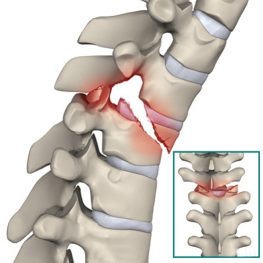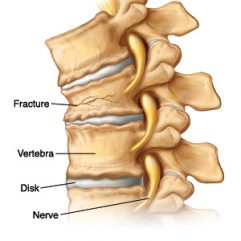Spinal fractures
Spinal fractures are various than a broken arm or leg. A fracture or dislocation of a vertebra can make bone fragments to pinch and break the spinal nerves or spinal cord. Most spinal fractures happen from car accidents, falls, or sports. Damages can vary from nearly mild ligament and muscle strains to cracks and dislocations of the bony vertebrae to debilitating spinal cord injury. Depending on how close your damage is, you may feel pain, trouble walking, or be weak to move your arms or legs. Several fractures heal with conventional treatment but, critical fractures may need surgery to realign the bones.
Spinal cracks and dislocations can pinch, compress, and even cut the spinal cord. Treatment of spinal fractures depends on what kind of fracture and the level of anxiety.
Fractures can happen anywhere along the spine. 5% to 10% happen in the neck region. 64% transpire in the low back region, usually at T12-L1.
There are many classifications for fractures. overall, spine fractures fall into three categories:
- Fractures
- Dislocations
- Fracture-dislocations


Symptoms and Signs of a spinal fracture depending on the hardness and location of the injury.
In which include :
1. back or neck pain
2. numbness
3. tingling
4. muscle spasm
5. weakness
6. bowel/bladder changes
7. and paralysis.
Paralysis is a lack of movement in the arms or legs and may show a spinal cord injury. Not all cracks create spinal cord injury and seldom is the spinal cord entirely severed.
Spinal stenosis in the cervical spine may occur in pressure on the nerves producing pain to the upper extremities, or it may occur in pressure on the spinal cord producing in likely spinal injury. Signs of this spinal damage may be a pain in the neck as well as pain in controlling the arms and legs, numbness through the body, bowel and bladder problems, and increased reflexes in the lower extremities.
Primary causes of spinal fracture:
1.Car accidents (45%)
2.falls (20%)
3.sports (15%)
4.acts of violence (15%)
5.miscellaneous activities (5%)
and other Diseases causes such as osteoporosis and spine tumors also add to fractures.
In maximum cases of a spinal injury, paramedics will get you to an emergency room (ER). The first doctor to see you in the ER is an Emergency Medicine expert who is a member of the trauma team. Depending on your damages, other experts will be asked to evaluate your situation. The doctors will evaluate your breathing and do a physical exam of the spine. The spine is held in a neck or back support until proper diagnostic tests are performed.
X-ray analysis do x-rays to see the bony vertebrae in your spine and can show your physician if any of them give fractures. Special flexion and extension x-rays may be used to identify any unusual movement.
Computed Tomography (CT) scan is a reliable, noninvasive test that does an X-ray beam and a computer to make 2-dimensional pictures of your spine. It may or may not be done with a dye inserted into your bloodstream. It is particularly helpful for seeing differences in bony structures.
Magnetic Resonance Imaging (MRI) scan is a noninvasive test that utilizes a magnetic field and radiofrequency waves to provide a full view of the soft tissues of your spine. Unlike an X-ray, nerves and discs are apparent. It may or may not be done with a dye (contrast agent) inserted into your bloodstream. MRI helps evaluate soft tissue injury to the ligaments and discs and evaluating spinal cord damage.
Treatment of a fracture occurs with pain control and stabilization to stop further damage. Other body injuries maybe require treatment as well. Depending on the kind of break and its resistance, bracing and surgery may be required.
Braces & Orthotics do 3 things, 1) controls spinal alignment; 2) immobilizes your spine during healing; and 3) measures pain by limiting movement. Even fractures may only need stabilization with a brace, such as a hard collar for cervical fractures, a cervical-thoracic brace for upper back fractures, or a thoracolumbar-sacral orthosis for lower back fractures. After weeks the brace is normally ended. Unstable neck breaks or dislocations may need traction to realign the spine into its right position. A light ring and vest brace may be needed.
Instrumentation & Fusion are surgical methods to use variable fractures. Fusion is the joining of two vertebrae with a bone graft taken concurrently with hardware such as plates, rods, hooks, pedicle screws, or cages. The bone graft aims to connect the vertebrae above and below to form one solid piece of bone. It may take many longers to produce a solid fusion.
Vertebroplasty & Kyphoplasty are minimally invasive methods performed to use concentration breaks usually made by osteoporosis and spinal tumors. In vertebroplasty, bone cement is inserted through a hollow needle into the fractured vertebral body. In kyphoplasty, a balloon is first entered and expanded to open the compressed vertebra before filling the space with bone cement.